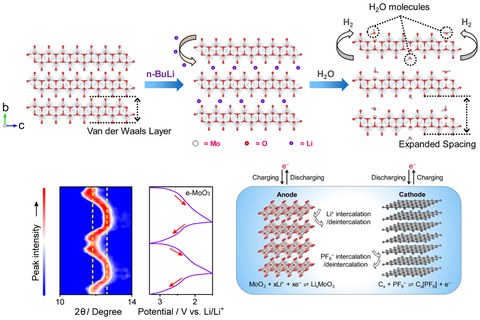18.03.2020
A new vdW gap engineering paradigm enables high-kinetics α-MoO3 anodes for dual-ion energy storage devices
Efficient energy storage means storing energy, not only in substantial amounts, but also with significant velocities. However, to date, mitigating the inherent trade-off between energy density and power density remains highly challenging for electrochemical energy storage technologies. Assembling energy storage systems with fast-kinetics ion-intercalation electrodes represents a feasible way, but there is still lack of efficient approaches that remarkably enhance the charge storage kinetics of an ion-intercalation electrode.
Recently, researchers from Technische Universität Dresden (Chair of Molecular Functional Materials) and collaborators (CIRIMAT, France) reported a new paradigm for the van der Waals (vdW) gap engineering of α-MoO3. H2O molecules were incorporated into the vdW interlayers of α-MoO3 by taking the place of lattice O in α-MoO3, which further induced an exceptional vdW gap expansion with b-lattice parameter increased by 1.2 Å. The incorporated H2O molecules can not only function as effective spacers to stabilize the expanded interlayer gaps of α-MoO3, but also shield the strong electrostatic interaction between Li+ and α-MoO3 lattice, thus providing efficient Li+ diffusion channels and alleviating the volume change of e-MoO3 during repeated Li intercalation/de-intercalation. These properties further empowered the modified α-MoO3 as a high-rate, long-life, and reliable anode for dual-ion-intercalation energy storage (DIES) devices. The as-assembled MoO3//graphite DIES device can operate within a 1.0 ~ 3.5 V voltage window over a wide discharge rate range (discharge time from 25 s to 3.5 h), and show high energy density (device-level 44 Wh L−1) with decent power capability (600 W L−1).
This work was financially supported by the European Research Council (ERC) under the European Union’s Horizon 2020 research and innovation programme (grant agreement No 819698 and GrapheneCore2 785219), Deutsche Forschungsgemeinschaft (MX‐OSMOPED project), and German Research Foundation (DFG) within the Cluster of Excellence. H. Shao, P. Rozier, and P. Simon thank the Agence Nationale de la Recherche (Label STORE-EX) for financial support. The authors acknowledge the use of the facilities in the Dresden Center for Nanoanalysis at the Technische Universität Dresden and synchrotron experimental facilities of the National Synchrotron Radiation Laboratory (NSRL) in Hefei, China (BL10B beamline).
Reference:
Minghao Yu, Hui Shao, Gang Wang, Fan Yang, Chaolun Liang, Patrick Rozier, Cai-Zhuang Wang, Xihong Lu, Patrice Simon* & Xinliang Feng*, Interlayer gap widened α-phase molybdenum trioxide as high-rate anodes for dual-ion-intercalation energy storage devices, Nat. Commun., 2020, 11, 1348.

